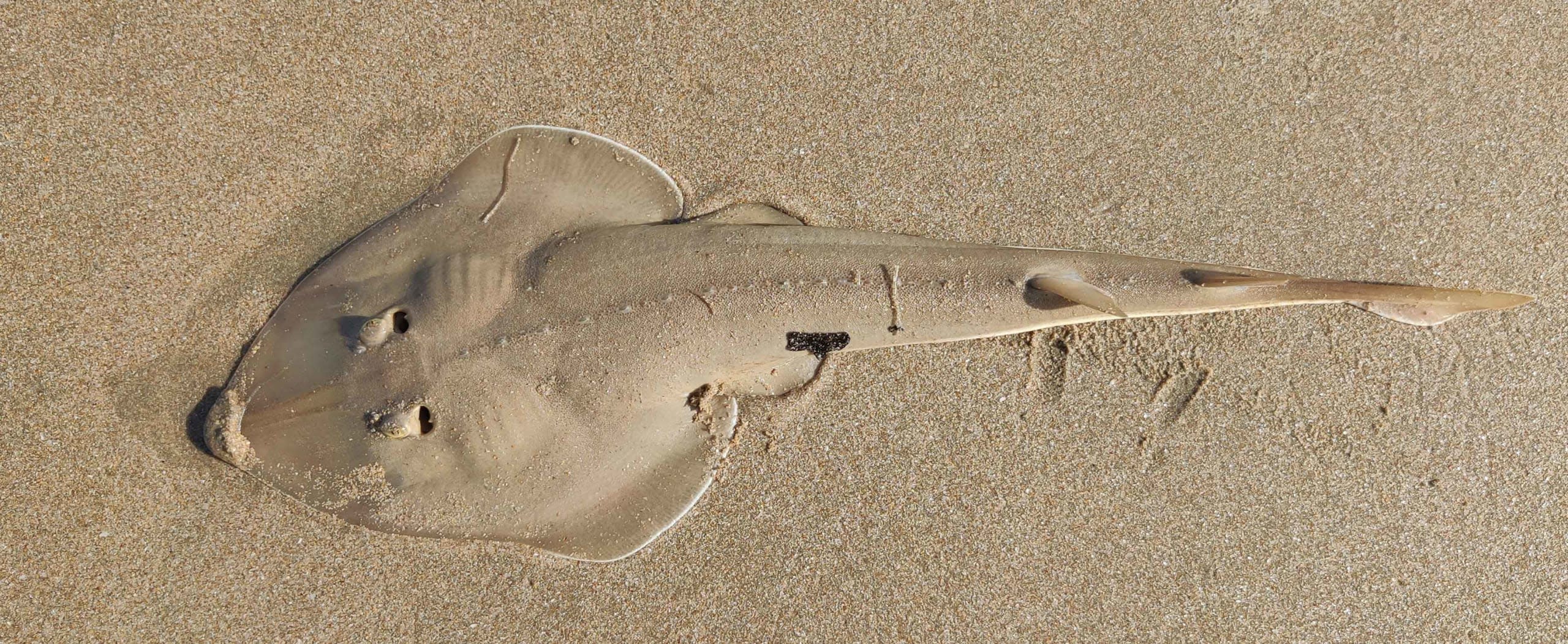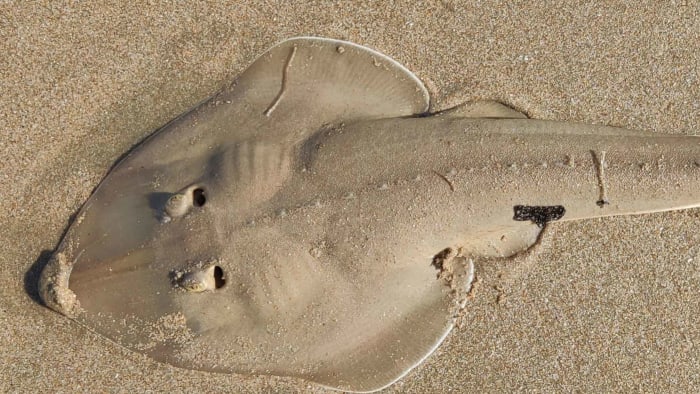 Listen to this article
•
15:34 min
Listen to this article
•
15:34 min
It moved so fast; I would’ve missed it if I’d blinked. The guitarfish cut its way through the shallow water, leaving a line of ripples behind as it vanished into the dark night sea.
This strange-looking creature belongs to an enigmatic group of marine life known by many names, including guitarfish, shark-like ray, and rhino ray. Guitarfish are a part of a larger group called elasmobranchs (cartilaginous fishes), which also include well-known ocean critters like sharks and manta rays. Elasmobranchs are one of the most threatened groups of animals today due to human activities like fishing, coastal development, and pollution.
In late 2020, I visited a quiet beach in South Goa on India’s west coast where (I had been told) guitarfish often aggregate in the shallow waters at sunset. I walked along the beach at dusk with a few friends, trying to spot them, but my excitement slowly faded as the hour passed with no sign of them. Just when I had lost hope and was going to call it a night, we caught a quick movement in the water as a wave rolled in. In water as shallow as a few inches, a small guitarfish came in with the wave and rapidly swam back as the water receded. It stayed close to the seafloor, its brownish-white body camouflaging so perfectly with the sand that we nearly missed it.

Cover photo: Widenose guitarfish are found in the coastal waters of South and Southeast Asia. They are the smallest species of the giant guitarfish family (Glaucostegidae), growing to a maximum length of about 1 metre. Photo: Bryan Miranda
It was a widenose guitarfish (Glaucostegus obtusus), a “Critically Endangered” species, according to the IUCN Red List. Despite working with guitarfish, elasmobranchs, and their fisheries for several years, this was my first sighting of a live guitarfish in its natural habitat. Little did I know that this would be the first of many; I’ve been studying guitarfish in this region ever since. Amongst elasmobranchs, guitarfish are especially in trouble as most species face extinction. As they inhabit nearshore waters, they are threatened by the different fisheries operating in this zone. Being slow-growing animals with a low reproductive output, they cannot easily recover from this fishing pressure. But there’s still so little we know about guitarfish and their behaviour. How do you begin to conserve what you don’t understand?
My colleagues and I are addressing some of these gaps by studying how and why guitarfish use these coastal waters in South Goa and how their habitats overlap with human activities; we’re supported by Save Our Seas Foundation, FERAL and InseasonFish.
Ancient dwellers of the seafloor
Since they first evolved over 100 million years ago, guitarfish have been benthic (bottom-dwelling), spending most of their time on the seafloor. Locals in Goa recite stories of how guitarfish bury themselves in the sand and conceal so well that you could be staring right at them and not realise they are present. We know very little about their behaviour and role in this ecosystem, but recent studies have found that guitarfish, along with other benthic rays, are important “bioturbators”. By that, we mean they excavate and disturb the sediments of the seafloor; this action can be vital for nutrient cycles. Guitarfish dig into the sediment while hunting and eating fish, crabs and prawns that live there. They also feed on tiny benthic organisms that get exposed by wave action, which might be why they venture into shallow waters and risk getting beached. Curiously, it’s mostly young guitarfish that we’ve seen on the shore. We suspect that the coastal waters of some of Goa’s beaches are nurseries for guitarfish — habitats where young fish grow up, with abundant food and safety from predators. Nursery grounds are important for many marine species, forming key habitats in their life cycles and, hence, pivotal sites for conservation action.
We’ve been surveying different beaches in Goa to understand how the abundance of young guitarfish varies between sites and whether this is linked to environmental factors, tourism levels, and time of the year. Mostly, we survey at night and early in the morning, as they appear to be most active at those times. We’ve especially seen high numbers of young guitarfish in Galgibaga beach, at the southern end of Goa. In fact, our work helped identify Galgibaga Beach as an Important Shark and Ray Area, given its potentially important role in supporting these critically endangered species. They may prefer this beach as it is relatively undisturbed with limited tourism. It’s thrilling to see guitarfish in these seemingly large numbers, but all evidence suggests that their populations now are just a fraction of what they were a few decades ago. Urgent conservation efforts are needed to ensure the continued existence of these ancient species.
Collective conservation action
Recently, several elasmobranch species, including the widenose guitarfish and other guitarfish, have been listed under Appendix I of India’s Wildlife Protection Act. This offers them the same level of protection as a tiger, and they cannot be fished or traded. It will be some time before this policy amendment is implemented on the ground, and its impacts (positive and negative) on guitarfish populations and local livelihoods remain to be seen. While policy action can be crucial, enforcement will remain a challenge. For these measures to be successful, we need to have the participation of local communities.
There are signs of hope from around the world. Researchers in Brazil have started a live release program where local fishers voluntarily release threatened guitarfish back into the water when caught. Colleagues in Indonesia are trialling an incentive programme to encourage fishers to release other threatened elasmobranchs from their boats safely. Similar live release programmes may work in places like Goa. Our previous research in 2021 found that fishers have positive attitudes towards guitarfish conservation since they are a low-value bycatch species. This can be the first step towards saving these species while helping fishers comply with the new wildlife policies. Over the longer term, we hope to devise strategies to protect their critical habitats in the crucial seasons (such as breeding) by better understanding how young guitarfish use the coastal waters.
As I head out to join my colleagues for an evening survey, I still feel a spark of excitement at spotting these young guitarfish swimming through the waves. I hope that we can pull them away from the brink of extinction so that future generations can see guitarfish with the same excitement.
This work is supported by the Save Our Seas Foundation, FERAL, and the Levine Family Foundation.








